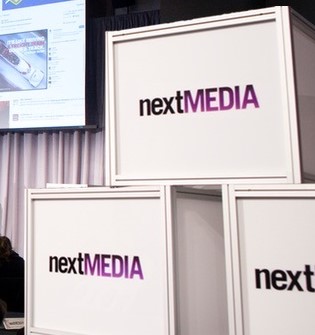
TORONTO – It was another first, as in my first communications or cultural industries conference that was trending in the top five on Twitter – along with the audience getting regular Twitter metrics updates at bio breaks and lunch.
Pretty cool for a Greybeard!
And it sure as shootin' is a new world: 66% of us have Smartphones now, 46% of us watch TV on the Internet, video has a scant seconds or less to win a viewer, and we’re immersed, for better or worse, in a $22 billion digital economy.
Walter Levitt, Chief Marketing Officer at Comedy Central in NYC – a proud Canadian who led the marketing at both Alliance Atlantis and Shaw Media – made it clear that, in this economy, the business focus is on millennials – or what we used to call the 18-34 demographic.
And within that millennial market, the guys are his prime target. For Comedy Central (CC) the data shows that 47% of this target identifies strongest with comedy vs. only 22% with sports or 20% with political fare.
Plus, Heaven help us, for CC they are no longer a TV network. The words TV or television have been scrubbed from all CC brand references and brand characterizations… replaced with "CC, comedy, always available everywhere!"
The recasting of The Daily Show with Trevor Noah as host is a prime example. According to Levitt, more and more of what happens with the show happens away from TV. This means highly responsive, designed research to drive Google searches and, while monetization is not quite there, a recognition that social media is vital to engagement and itself morphs every six months.
Nobody should be sanely planning three years ahead in our business, says Levitt, only quarter-by-quarter given the dynamism of the digital space, Uber-style sharing, and the fact that digital is where the consumer is going.
For CC, social media is critical for building brand trust. Dead is the simple content-provider business model.
And it gets even less simple.
Tony Chapman, founder of Tony Chapman Reactions, refers to old-speak listeners and viewers as "digital natives" where marketing has given way to "marketing technologists".
Today's business model is hinged on the new mindset of leveraged engagement – so much for the old sales guys’ ABC (always be closing) approach.
Sure, you can't beat TV for broad reach and it still gets about 70% of the ad spend, but even old stock companies like Canadian Tire and Air Canada, are fast into this culture shift.
Susan O'Brien, VP, Marketing, Canadian Tire, says she now looks at her marketing through the lens of two queries: why shop or stay with us, and "why do you love us?"
Canadian Tire is also moving away from mass "driftnet marketing" towards "fly-fishing" for personal connectivity.
Nope, not couples’ therapy, but the kind of novel thinking that gave rise to the retailer’s wonderful "We All Play for Canada" campaign. Canadian Tire is also moving away from mass "driftnet marketing" towards "fly-fishing" for personal connectivity.
Put another way, the path to purchase is increasingly a digital pathway.
Over at Air Canada, that translates into something called "the customer journey – but where 60% of Canadians are online searching or dreaming of travel, but only 20% are ready to convert (a.k.a. buy)", says Selma Filali, senior director, marketing communications.
To Filali's way of thinking, if the airline only reaches customers the old way, and only in the buy phase, it's likely too late because at that point the "conversion" will be based on price – not always an Air Canada closer.
Rather the fresh strategy is to employ social media campaigns to sell warm and fuzzy company attributes, not retail products. The company’s "Gift of Home" initiative is a good example.
There the goal was an emotional connection to the 3.3 million online viewers that gave Air Canada a 95% approval rating. This says Filali, is social media marketing conceived as a one-to-one, "moment of receptivity", approach.
(If only the synchronized delivery of my checked baggage was given such doe-eyed care.)
One other neat note… the airline recently started a new route to Dubai and involved about "50 social enablers with large social media followings" in the launch… yup, not a single Gardiner Expressway billboard to be found in the ad spend.
Let's face it… this is a permanent seismic shift, ignored at a broadcaster's or media mogul's peril and even the comfy ad agencies are fessing up to that fact. Agencies are now opening up their rosters, seeking more freelancers, and staying in tune with the Uber-ization of creative.
And this is increasingly true for agencies of record, especially when companies like Canadian Tire and Air Canada see them as competent for the core business, but less so for anything digital or truly socially innovative.
A good example of this is PepsiCo crowd-sourcing its NFL Super Bowl Doritos ads: the consumer likely knows the product better than the agencies do! Which means static, no-engagement, television ads are not cutting it anymore.
They are being replaced by a generation of creators and consumers at ease in a world of social media micro-moments based on algorithms catching Gen Zers and millennials with video of pizza-eating NYC rats harvesting 47 million viral views in just seven days!
Okay, it's a mouthful.
But it's also the appetite of the future.



